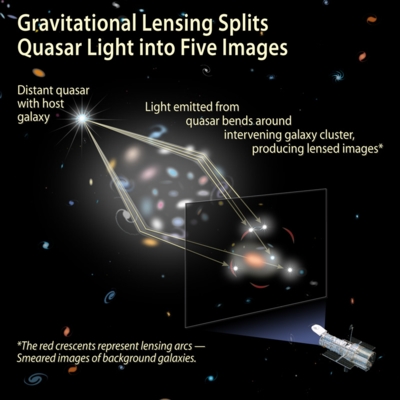somebodyshort wrote:2 questions
1) Why is the background image not a circle? It doesn't have to be a perfect circle because the mass is not spherical.
2) Are the images all in the same place at all light frequencies. I would think there is some prism effect and scatter the light like a prism.
In order to get an
Einstein ring, the foreground lensing galaxy (the red one), the background galaxy being lensed (the blue one) and the observer looking at the ring have to be perfectly aligned. See
Astronomy Picture of the Day for December 21, 2011.
By the way, why are the lensing galaxies always red and the lensed galaxies almost always blue? I'd say it's inevitable that the lensing galaxy or galaxies have to be one or more supermassive elliptical galaxies, and such galaxies are always "red and dead", with no (or hardly any) discernible star formation. The reason why such galaxies are the perfect cosmic lenses is because they are the greatest mass concentrations in the universe. What about supermassive black holes? There are several reasons why supermassive black holes can't do a good lensing job by themselves. First of all, there almost certainly doesn't exist a single "galaxy-less" supermassive black hole in the universe. The supermassive black holes are always surrounded by a galaxy. And obviously the black hole
plus the galaxy are a lot more massive together than the black hole on its own. In any case, even a supermassive black hole is puny when it comes to mass compared with the most massive elliptical galaxies. Also the galaxy is so
very much more extended than the black hole, and a large lens can do a lot more lensing than a tiny one.
Why are the lensed galaxies always blue? That's a trickier question. They don't
have to be blue, but they usually are. The reason is probably that the lensed galaxies hail from an epoch when the universe was blue and bursting with star formation well before the gigantic elliptical galaxies had been formed. So we are seeing "very early" brilliantly blue and star forming not-very-massive-for-their-brilliance galaxies, which are the perfect lensed galaxies, and "much later" supermassive, not-very-bright-for-their-mass red elliptical galaxies, which are the perfect cosmic lenses.
What was the second question you asked, are lensing galaxies like prisms? Well no, I don't think they are, because they are very fuzzy at the edges!
Ann
 Giant Cluster Bends, Breaks Images
Giant Cluster Bends, Breaks Images
